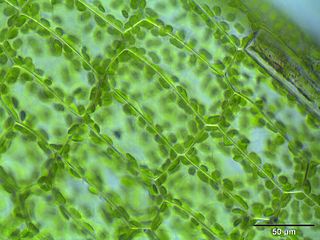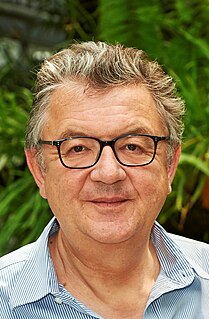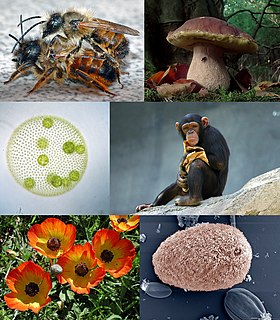
The cell is the basic structural, functional, and biological unit of all known organisms. A cell is the smallest unit of life. Cells are often called the "building blocks of life". The study of cells is called cell biology, cellular biology, or cytology.

In cell biology, the cytoplasm is all of the material within a cell, enclosed by the cell membrane, except for the cell nucleus. The material inside the nucleus and contained within the nuclear membrane is termed the nucleoplasm. The main components of the cytoplasm are cytosol – a gel-like substance, the organelles – the cell's internal sub-structures, and various cytoplasmic inclusions. The cytoplasm is about 80% water and usually colorless.

Chloroplasts are organelles that conduct photosynthesis, where the photosynthetic pigment chlorophyll captures the energy from sunlight, converts it, and stores it in the energy-storage molecules ATP and NADPH while freeing oxygen from water in plant and algal cells. They then use the ATP and NADPH to make organic molecules from carbon dioxide in a process known as the Calvin cycle. Chloroplasts carry out a number of other functions, including fatty acid synthesis, much amino acid synthesis, and the immune response in plants. The number of chloroplasts per cell varies from one, in unicellular algae, up to 100 in plants like Arabidopsis and wheat.

The endomembrane system is composed of the different membranes that are suspended in the cytoplasm within a eukaryotic cell. These membranes divide the cell into functional and structural compartments, or organelles. In eukaryotes the organelles of the endomembrane system include: the nuclear membrane, the endoplasmic reticulum, the Golgi apparatus, lysosomes, vesicles, endosomes, and plasma (cell) membrane among others. The system is defined more accurately as the set of membranes that form a single functional and developmental unit, either being connected directly, or exchanging material through vesicle transport. Importantly, the endomembrane system does not include the membranes of chloroplasts or mitochondria, but might have evolved from the latter.
In cell biology, an organelle is a specialized subunit within a cell that has a specific function. Organelles are either separately enclosed within their own lipid bilayers or are spatially distinct functional units without a surrounding lipid bilayer.

Symbiogenesis, or endosymbiotic theory, is an evolutionary theory of the origin of eukaryotic cells from prokaryotic organisms, first articulated in 1905 and 1910 by the Russian botanist Konstantin Mereschkowski, and advanced and substantiated with microbiological evidence by Lynn Margulis in 1967. It holds that the organelles distinguishing eukaryote cells evolved through symbiosis of individual single-celled prokaryotes . The theory holds that mitochondria, plastids such as chloroplasts, and possibly other organelles of eukaryotic cells represent formerly free-living prokaryotes taken one inside the other in endosymbiosis. In more detail, mitochondria appear to be related to Rickettsiales proteobacteria, and chloroplasts to nitrogen-fixing filamentous cyanobacteria. Among the many lines of evidence supporting symbiogenesis are that new mitochondria and plastids are formed only through binary fission, and that cells cannot create new ones otherwise; that the transport proteins called porins are found in the outer membranes of mitochondria, chloroplasts and bacterial cell membranes; that cardiolipin is found only in the inner mitochondrial membrane and bacterial cell membranes; and that some mitochondria and plastids contain single circular DNA molecules similar to the chromosomes of bacteria.

The plastid is a membrane-bound organelle found in the cells of plants, algae, and some other eukaryotic organisms. They are considered endosymbiotic Cyanobacteria, related to the Gloeomargarita. Plastids were discovered and named by Ernst Haeckel, but A. F. W. Schimper was the first to provide a clear definition. Plastids are the site of manufacture and storage of important chemical compounds used by the cells of autotrophic eukaryotes. They often contain pigments used in photosynthesis, and the types of pigments in a plastid determine the cell's color. They have a common evolutionary origin and possess a double-stranded DNA molecule that is circular, like that of prokaryotic cells.

Cytoplasmic streaming, also called protoplasmic streaming and cyclosis, is where there is flow inside the cytoplasm. It is typically observed in large plant and animal cells. Here flow means that the cytoplasm is moving inside the cell, it is not stationary. The flow is driven by forces from the cytoskeleton, and it is likely that the function of flow is at least partly to speed up transport of molecules and organelles around the cell. Cytoplasmic streaming is usually found in unusually large cells, greater than approximately 0.1 mm. In smaller cells, diffusion of molecules will be rapid but diffusion slows rapidly as the size increases, and so larger cells may need flow to move nutrients etc. inside them rapidly enough for efficient function.

A hydrogenosome is a membrane-enclosed organelle of some anaerobic ciliates, trichomonads, fungi, and animals. The hydrogenosomes of trichomonads produce molecular hydrogen, acetate, carbon dioxide and ATP by the combined actions of pyruvate:ferredoxin oxido-reductase, hydrogenase, acetate:succinate CoA transferase and succinate thiokinase. Superoxide dismutase, malate dehydrogenase (decarboxylating), ferredoxin, adenylate kinase and NADH:ferredoxin oxido-reductase are also localized in the hydrogenosome. It is nearly universally accepted that hydrogenosomes evolved from mitochondria.
Extrachromosomal DNA is any DNA that is found off the chromosomes, either inside or outside the nucleus of a cell. Most DNA in an individual genome is found in chromosomes contained in the nucleus. Multiple forms of extrachromosomal DNA exist and serve important biological functions, e.g. they can play a role in disease, such as ecDNA in cancer.
Cellular compartments in cell biology comprise all of the closed parts within the cytosol of a eukaryotic cell, usually surrounded by a single or double lipid layer membrane. These compartments are often, but not always, defined as membrane enclosed regions. The formation of cellular compartments is called compartmentalization.
Immune Attack is an educational video game created by the Federation of American Scientists and Escape Hatch Entertainment. Early development of the game was done by Brown University, in collaboration with the University of Southern California, under a grant from the National Science Foundation. The game is designed to teach immunology to high school students, although later versions will cater to college aged students as well.

The following outline is provided as an overview of and topical guide to cell biology:

Ralf Reski is a German Professor of Plant Biotechnology and former Dean of the Faculty of Biology of the University of Freiburg. He is also affiliated to the French École supérieure de biotechnologie Strasbourg (ESBS) and Senior Fellow at the Freiburg Institute for Advanced Studies.
The CoRR hypothesis states that the location of genetic information in cytoplasmic organelles permits regulation of its expression by the reduction-oxidation ("redox") state of its gene products.

Eukaryotes are organisms whose cells have a nucleus enclosed within membranes, unlike prokaryotes, which have no membrane-bound organelles. Eukaryotes belong to the domain Eukaryota or Eukarya. Their name comes from the Greek εὖ and κάρυον. Eukaryotic cells also contain other membrane-bound organelles such as mitochondria and the Golgi apparatus, and in addition, some cells of plants and algae contain chloroplasts. Unlike unicellular archaea and bacteria, eukaryotes may also be multicellular and include organisms consisting of many cell types forming different kinds of tissue. Animals and plants are the most familiar eukaryotes.

History of Biology is a browser based scavenger hunt style educational game created by Spongelab Interactive. It is designed to teach high school students and general interest groups about the history of biology

Spongelab is a science education website for teachers and students created by Spongelab Interactive. The website provides a free online collection of multimedia including educational games, videos, images, and lesson plans, with a focus on game-based learning. Spongelab.com is a web-based teaching platform that allows educators to combine science, discovery learning tools and technology to create a visually engaging interactive whole. The website is a self-described “global science community” that has seen its base grow to more than 50,000 active monthly users. It stitches together interactive multimedia, online teaching and classroom metrics. Users gain points and credits for exploring the website, which can be used to unlock access to discounts for science education products.

Joanne Chory is an American plant biologist and geneticist. Chory is a professor and director of the Plant Molecular and Cellular Biology Laboratory, at the Salk Institute for Biological Studies and an investigator of the Howard Hughes Medical Institute. She holds the Howard H. and Maryam R. Newman Chair in Plant Biology. She is also an adjunct professor in the Section of Cell and Developmental Biology, UC San Diego.
Karen Koch is a plant biologist in the horticultural science department in the University of Florida. She is a professor in the Plant Molecular and Cellular Biology (PMCB) Program, Horticultural Sciences Department, and Genetics Institute at University of Florida.
(1) National Science Foundation - International Science & Engineering Visualization Challenge."Special Report". September 25, 2008
(2) National Science Foundation - International Science & Engineering Visualization Challenge."Special Report". February 19, 2010














